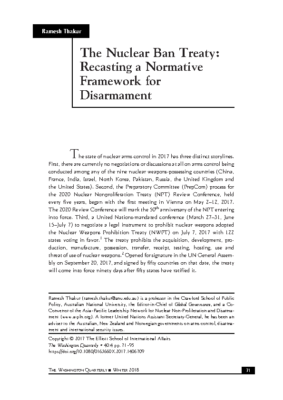– Ramesh Thakur
The state of nuclear arms control in 2017 has three distinct storylines. First, there are currently no negotiations or discussions at all on arms control being conducted among any of the nine nuclear weapons-possessing countries (China, France, India, Israel, North Korea, Pakistan, Russia, the United Kingdom and
the United States). Second, the Preparatory Committee (PrepCom) process for the 2020 Nuclear Nonproliferation Treaty (NPT) Review Conference, held every five years, began with the first meeting in Vienna on May 2–12, 2017.
The 2020 Review Conference will mark the 50th anniversary of the NPT entering into force. Third, a United Nations-mandated conference (March 27–31, June 15–July 7) to negotiate a legal instrument to prohibit nuclear weapons adopted the Nuclear Weapons Prohibition Treaty (NWPT) on July 7, 2017 with 122 states voting in favor.1 The treaty prohibits the acquisition, development, production, manufacture, possession, transfer, receipt, testing, hosting, use and threat of use of nuclear weapons.2 Opened for signature in the UN General Assembly on September 20, 2017, and signed by fifty countries on that date, the treaty will come into force ninety days after fifty states have ratified it.



